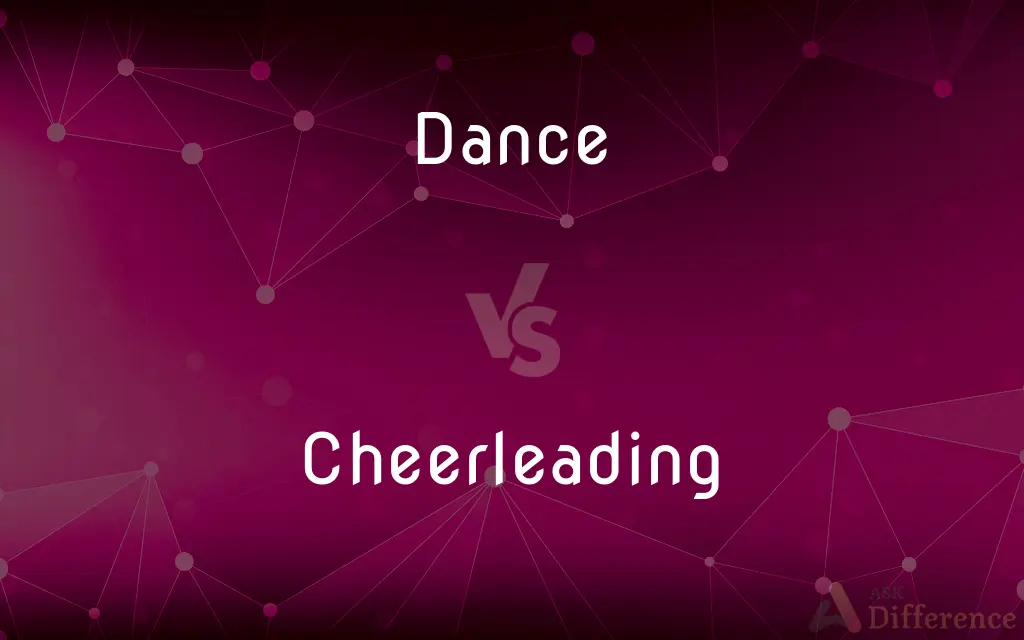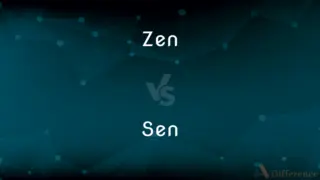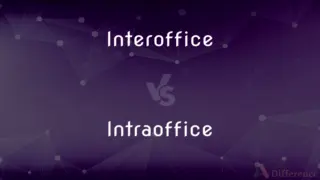Dance vs. Cheerleading — What's the Difference?
By Fiza Rafique & Urooj Arif — Updated on May 3, 2024
Dance focuses on artistic expression and technique in various styles, while cheerleading combines dance routines with stunts and team chants to boost team spirit at sporting events.

Difference Between Dance and Cheerleading
Table of Contents
ADVERTISEMENT
Key Differences
Dance is an art form centered on body movement, often set to music, where individuals or groups express emotions and stories through choreographed steps. Cheerleading, on the other hand, is a dynamic activity that blends dance, gymnastics, and acrobatic stunts to encourage and entertain spectators at sports events.
While dance styles range from ballet to hip-hop, each with its own specific techniques and cultural origins, cheerleading typically adheres to precise, sharp movements aimed at projecting energy and enthusiasm to large audiences. Dance performances focus on aesthetic appeal and technical mastery, whereas cheerleading emphasizes synchronization, team coordination, and spirited displays.
Dance often requires intense training to master specific styles and techniques, focusing on individual performance or small ensembles. Cheerleading, however, prioritizes teamwork and often involves lifting and throwing teammates, which requires trust and precise timing.
In terms of performance venues, dance can be showcased in a variety of settings from theaters to street corners depending on the style. Cheerleading is primarily performed during sports events, competitions, and pep rallies, specifically targeting sports fans and school spirit.
Dancers typically aim for emotional connection with their audience, using movements that can be interpretative and abstract. Cheerleaders strive for immediate impact and engagement, using chants and signs to directly interact with their audience and boost crowd participation.
ADVERTISEMENT
Comparison Chart
Focus
Artistic expression
Team spirit and support
Key Elements
Choreography, technique
Stunts, chants, dance
Performance Venue
Theaters, various settings
Sports events, competitions
Training
Style-specific techniques
Team coordination, stunts
Audience Interaction
Emotional connection
Direct engagement
Compare with Definitions
Dance
A performing art involving sequences of movements, often rhythmic and to music.
She attended dance classes to learn contemporary techniques.
Cheerleading
An activity involving elements of dance, jumps, cheers, and stunts to support teams at sports events.
She joined the cheerleading squad to boost school spirit.
Dance
A social gathering where participants dance.
The school dance was scheduled for Friday night.
Cheerleading
A competitive sport combining gymnastics, dance, and stunt performance.
The national cheerleading competition attracts top teams each year.
Dance
A genre of art focused on creating performances through movement.
Ballet is a highly disciplined classical dance form.
Cheerleading
A team activity that focuses on crowd leading and raising team spirit.
Their cheerleading routine fired up the crowd during halftime.
Dance
The act of moving rhythmically and expressively.
His dance to the music was mesmerizing at the party.
Cheerleading
The practice of using cheers to motivate sports teams.
Cheerleading at football games involves complex stunts and routines.
Dance
A prescribed sequence of steps and movements.
They perfected the dance before their performance.
Cheerleading
A form of entertainment and team expression at sports events.
The cheerleading team performed a new routine at every game.
Dance
Dance is a performing art form consisting of sequences of movement, either improvised or purposefully selected. This movement has aesthetic and often symbolic value.
Cheerleading
Cheerleading is an activity in which the participants (called cheerleaders) cheer for their team as a form of encouragement. It can range from chanting slogans to intense physical activity.
Dance
To move rhythmically usually to music, using prescribed or improvised steps and gestures.
Cheerleading
One who leads the cheering of spectators, as at a sports contest.
Dance
(Zoology) To perform a specialized set of movements to communicate chiefly with other members of the same species.
Cheerleading
A member of a group that performs coordinated routines typically combining gymnastic and dance maneuvers, originally including rhythmic chants to encourage spectators to cheer at an athletic event, but often in competition with similar groups.
Dance
To move or leap about excitedly.
Cheerleading
One who expresses praise for or promotes something enthusiastically.
Dance
To bob up and down or move about rapidly
The leaves danced in the wind.
Cheerleading
To lead organized cheering, as at sports events.
Dance
To appear to flash or twinkle
Eyes that danced with merriment.
Cheerleading
To express or promote automatic or servile praise
We want someone not just to cheerlead but to help us revamp our organization.
Dance
(Informal) To speak or behave in an evasive or vacillating manner
Danced around the issue.
Cheerleading
A physical activity in which cheerleaders organize elements of dance, gymnastics, and tumbling for judgment or to cheer on a team.
Dance
To engage in or perform (a dance).
Cheerleading
(figurative) Automatic or servile praise.
Dance
To lead (someone) in a dance.
Cheerleading
Present participle of cheerlead
Dance
To cause to move up and down quickly or lightly
Danced the child on her knee.
Dance
A series of motions and steps, such as the waltz or tango, usually performed to music.
Dance
The act or an instance of dancing
May I have this dance?.
Dance
The music composed or played for a certain kind of dance or for a particular dance.
Dance
The art of dancing
Studied dance in college.
Dance
A party or gathering of people for dancing.
Dance
(Zoology) An act of communication by dancing
A peacock's courtship dance.
Dance
A sequence of rhythmic steps or movements usually performed to music, for pleasure or as a form of social interaction.
Dance
A social gathering where dancing is the main activity.
Dance
(uncountable) The art, profession, and study of dancing.
Dance
(uncountable) A genre of modern music characterised by sampled beats, repetitive rhythms and few lyrics.
Dance
A piece of music with a particular dance rhythm.
Dance
(figurative) A battle of wits, especially one commonly fought between two rivals.
So how much longer are we gonna do this dance?
Dance
Any strenuous or difficult movement, action, or task.
Dance
(heraldry) A normally horizontal stripe called a fess that has been modified to zig-zag across the center of a coat of arms from dexter to sinister.
Dance
(apiology) A repetitive movement used in communication between worker honey bees.
Dance
The death throes of a hanged person.
Dance
(intransitive) To move with rhythmic steps or movements, especially in time to music.
I danced with her all night long.
These drum beats are making me dance!
Dance
(intransitive) To leap or move lightly and rapidly.
His eyes danced with pleasure as he spoke.
She accused her political opponent of dancing around the issue instead of confronting it.
Dance
(transitive) To perform the steps to.
Have you ever danced the tango?
Dance
(transitive) To cause to dance, or move nimbly or merrily about.
Dance
To make love or have sex.
You make me feel like dancing.
Dance
To make a repetitive movement in order to communicate to other worker honey bees.
Dance
To kick and convulse from the effects of being hanged.
Dance
To move with measured steps, or to a musical accompaniment; to go through, either alone or in company with others, with a regulated succession of movements, (commonly) to the sound of music; to trip or leap rhythmically.
Jack shall pipe and Gill shall dance.
Good shepherd, what fair swain is thisWhich dances with your daughter?
Dance
To move nimbly or merrily; to express pleasure by motion; to caper; to frisk; to skip about.
Then, 'tis time to dance off.
More dances my rapt heartThan when I first my wedded mistress saw.
Shadows in the glassy waters dance.
Where rivulets dance their wayward round.
Dance
To cause to dance, or move nimbly or merrily about, or up and down; to dandle.
To dance our ringlets to the whistling wind.
Thy grandsire loved thee well;Many a time he danced thee on his knee.
A man of his place, and so near our favor,To dance attendance on their lordships' pleasure.
Dance
The leaping, tripping, or measured stepping of one who dances; an amusement, in which the movements of the persons are regulated by art, in figures and in accord with music.
Dance
A tune by which dancing is regulated, as the minuet, the waltz, the cotillon, etc.
Of remedies of love she knew parchanceFor of that art she couth the olde dance.
Dance
An artistic form of nonverbal communication
Dance
A party of people assembled for dancing
Dance
Taking a series of rhythmical steps (and movements) in time to music
Dance
A party for social dancing
Dance
Move in a graceful and rhythmical way;
The young girl danced into the room
Dance
Move in a pattern; usually to musical accompaniment; do or perform a dance;
My husband and I like to dance at home to the radio
Dance
Skip, leap, or move up and down or sideways;
Dancing flames
The children danced with joy
Common Curiosities
Where do dancers and cheerleaders typically perform?
Dancers perform in various venues like theaters and festivals, whereas cheerleaders mainly perform at sports events.
What is the primary focus of dance compared to cheerleading?
Dance focuses on artistic expression through movement, while cheerleading is aimed at energizing and supporting sports teams.
How do the training requirements differ between dance and cheerleading?
Dance training focuses on mastering specific dance styles and techniques, while cheerleading training involves stunts, teamwork, and cheer routines.
Do both dance and cheerleading require teamwork?
While dance can be solo or in groups, cheerleading almost always requires coordinated team effort.
Are cheerleading and dance considered sports?
Dance is generally considered a performing art, and cheerleading is recognized as a competitive sport.
How does audience interaction differ between the two?
Dancers may evoke emotions subtly, while cheerleaders interact directly and energetically with their audience.
What skills are unique to cheerleading?
Stunt performing and building human pyramids are unique to cheerleading.
Can men participate in both dance and cheerleading?
Both activities are inclusive and open to all genders.
Can dance be part of cheerleading?
Yes, dance routines are integral to cheerleading, though they are combined with stunts and cheers.
Is expressive ability important in both dance and cheerleading?
Expressiveness is crucial in dance for conveying emotion, while in cheerleading, it's more about conveying enthusiasm and spirit.
How do costumes differ between dancers and cheerleaders?
Dance costumes vary widely by style, from tutus to streetwear; cheerleading uniforms are designed to be eye-catching and uniform across the team.
What is a common misconception about cheerleading?
A common misconception is that cheerleading is not as physically demanding as other sports.
Are there different styles within dance and cheerleading?
Dance has numerous styles like ballet, jazz, and modern; cheerleading styles are generally uniform but can vary in routine complexity.
What type of music is typically used in dance and cheerleading?
Dance can use a broad range of music, from classical to hip-hop; cheerleading music is typically upbeat and fast-paced to energize the crowd.
What are the professional opportunities for dancers compared to cheerleaders?
Dancers can pursue careers in performance, choreography, and teaching; professional opportunities for cheerleaders include coaching, professional sports cheer squads, and competitive cheerleading.
Share Your Discovery

Previous Comparison
Zen vs. Sen
Next Comparison
Interoffice vs. IntraofficeAuthor Spotlight
Written by
Fiza RafiqueFiza Rafique is a skilled content writer at AskDifference.com, where she meticulously refines and enhances written pieces. Drawing from her vast editorial expertise, Fiza ensures clarity, accuracy, and precision in every article. Passionate about language, she continually seeks to elevate the quality of content for readers worldwide.
Co-written by
Urooj ArifUrooj is a skilled content writer at Ask Difference, known for her exceptional ability to simplify complex topics into engaging and informative content. With a passion for research and a flair for clear, concise writing, she consistently delivers articles that resonate with our diverse audience.
















































